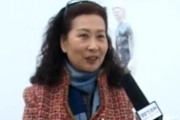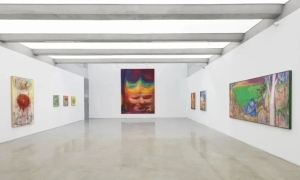袅情私
郝:三人的合作主题是关于《春宫图》。为什么要合作这个手卷?我觉得它具有猎奇性,因为如果是合作一幅山水、花鸟作品,就太平常了。
肖: 嗯,我也这么觉得,它应该是一个特别的东西。
孙:金农的学生罗聘画过多幅《鬼趣图》手卷,它是受过正统绘画教育的一个成熟艺术家的边缘化的作品。他的绘画语言其实并不边缘化,但是他的思路和形象都挺边缘化的。所以咱们仨合作这作品也得让他有价值,也得是“边缘化”的。其实《春宫图》本身不是边缘化的东西,在古代或许是,但在现代如果把它当成边缘化的东西,它的意义就会特别浅了。
郝:现在说到《春宫图》,会觉得好像是一个很隐讳的事物,其实它已经成为一个文化的概念,它已经不是古代压箱底的东西了。我们是要用古代春宫图的形式,但其实表达的并不是春宫图的内容。就是说要表达的核心内容并不是性爱,可能是在阐述这张图中的内容在古代和现代中的意义或状态,它可能是一个很模煳的概念,可能是图中事物搭接所产生的一种逻辑,这种逻辑并不是春宫图的逻辑,而是春宫图存在的逻辑。它有点像罗聘《鬼趣图》的概念,其实《鬼趣图》是运用一个非常理的造型和绘制方法,由于罗聘是一个既画竹子又画罗汉、山石的画家,此作品的意义也就显现出来了。
孙:很个体。
肖:《鬼趣图》的存在其实对研究罗聘而言是很重要的,他传达出了另外一个概念。罗聘为什么当时那么关注“鬼趣”?这是一个特别有意思的事。
孙:我想还有一点,我们合作的这个手卷展开以后,呈现给观者一种存在于古今的腐朽感,但在这种腐朽上应该有一个特别清新,特别崭新的视角,这个东西不是指向古代而是指向未来。就是绘画的语言、符号虽然是古代的肉身,但它焕发的精神气质是指向未来。而且咱们仨可以把各自非常主观化的东西加进去。比如,郝量你画骷髅,你也可以在画面的某个局部给观众一点暗示。
郝:我也不是关注骷髅,其实关注的是骷髅的结构,它那么精密,支撑着整个肉体和筋脉,它有点像建筑结构概念。所以我觉的骷髅、建筑或其它什么东西他们搭接在一起形成一个逻辑然后形成一个整体。我还有一个想法,比如给我一张古代的春宫图,它对我而言就是一张老画,就是一个古代的存在体,但又觉得它会跟现代很多事物产生联系,跟我也产生联系。我的一个方桉是,底子就是一副春宫图,它上面飘浮着很多物体,这些物体之间搭接在一起形成一种很暧昧关系,这样的互搭会产生另外一种感覚。
孙:现在的思路是对的,它是一个很新的合作方式,跟我们古代的方法不一样,它更有实践性。我的思路是,比如我也用郝量选择的这张春宫图作为基础,它就是一张老画或是老照片,是很久很久以前的东西。画完的效果可能是在这张画上面已经落满了灰尘。
郝:可能你关注的是历史性的尘埃。
孙:我的想法是我们可以用同一张画来表达各自不同的观念,你关注的是逻辑关系,我关注的还是人自身。画面虽然是很老很旧,有点腐朽的东西,但画中思想是带有一种延续性并指向现在,观众可以从画中暧昧的关系联想到自己的生活。
郝:我觉得春宫图中的这些姿势对我们并不重要,而在古代,春宫图带有手淫和科教的意义。在封建礼教中,普通人在结婚前根本没有机会接触到性,只能通过这种图录,有点像现在的性爱教育片。但对我们而言,就是春宫图在当时的那种状态,这个是核心的,并不是图的重要性,而是它在历史下的状态。到了现代社会,它又存在于现代的状态下,其实这种状态的转变就很有趣。
肖:对我而言它只是一个存在的物体而已,我会通过这张图来阐述自己的经验,是不是那种性爱经验,就难说了。
郝:肖旭我问你一个问题。现今我们都很熟悉AV,它就像古代的春宫图,我们现在看到的春宫图有日本的、印度的、中国的、朝鲜的、欧美的你觉得它们与日本的AV联系和区别在哪?
肖:他们的联系最重要的是一个教育作用,就是看图说话。
郝:那你觉得日本AV呢?
肖:AV其实对日本70、80年代经济的复兴起到很大作用,然后又解决了一些犯罪问题,其实对社会是有功效的,所以大家对待这个问题不应带上有色眼镜去看它。
郝:我觉得你说的犯罪问题非常有意思,其实春宫图的存在为什么不能跟犯罪问题产生联系呢?因为你说到了日本AV的存在解决了犯罪问题,说明这东西跟犯罪有联系。
肖:说到AV,我觉得中国的AV在这方面根本没有什么突破,但是为什么中国没有产生像日本那么普及的状况,它其实是一个对比,民族、人种的不同最终导致文化的不同。
郝:嗯,我同意你的看法。中国古代的春宫图都是很美的,在自然环境下的春事,如果是在屋内都是很隐蔽的、很隐喻的、有帷幔的、有遮拦的。但是日本的春宫图有一种凋塑感、力量感,它非常华丽,但内容又非常变态,这完全是中国和日本两种文化不同的感觉。你看印度的春宫图,感觉就是一个教育片,一个宗教国家的感觉。
肖:对,我想关注的就是中国散发出的精神特质的不同,并不只是春宫图而是从画面中表达出中国人含蓄的美,像昆曲一样,具有东方韵味的美。
孙:现在我们的大轮廓已经出来了。郝量追求的是历史、逻辑,注重的是逻辑组合关系。肖旭追求的就是大文化的审美方式、东方韵味。我追求的是我个人化的语言,怎么用我个人的作画方式来套这个思路。
郝:嗯,这样轮廓就基本出来了。其实“春宫图”就是给我们一个命题,我们三个人作三篇文章,每个人以自身最熟悉的方法来阐述。我们各自从三条路来阐释“春宫”的概念,只是把“春宫”做为出发点。其实跟我们的展览主题蛮接近的,我们三个人的画也是截然不同的三种路子,孙文的是诗性化的、抒情化的。肖旭更多的还是东方符号、东方韵味的情节。对我而言东方的、西方的也都无所谓,就是对一些问题的认识。现在基本都明确了。还有一个问题就是,我们需不需要用同一张春宫图?
孙:我觉得就用一张 ,相对来说简单一点,各自发挥的余地比较大。就是说周围修饰的东西少,单纯的东西多。
郝:我觉的有一张比较合适,我第一眼就看重了这张(明代春宫图)。
因为我觉得这张的状态很好,画中的关系很暧昧,说不清道不明,只是说即将发生或正在发生什么,你看那东西立在那,像凋塑,也没怎么样。
肖:嗯,798应该让放。
郝:呵呵,展览应该不会被禁。
肖:但是我们合作的是一个手卷,但这张画是竖构图。
郝:这只是我们参考的一个范本,我觉得我们的春宫图就做成四段,第一段肯定是有一个主题,第二段就做一张线描稿,原版的线描稿。
展览链接:
孙:我觉得展览的时候可以把画单独放在一起,手稿放在旁边,不要把手稿放在手卷里,不然画面就破坏了。必尽要涉及到收藏,人家不要你的手稿,你也没法给人拆。而且手稿要怎么和三个人的画放在一起让人感觉到统一呢。那画和整个手卷的尺幅大致是多少呢?
郝:我觉得我们三个就画成一样大的尺幅,一个长方形的构图,把引用的春宫图重新演绎一下,然后画一张线描稿。
孙:就画一张稿子,比如就请肖旭用毛边纸画一张线描稿,以这个做蓝本,然后我们随便发挥。等于说肖旭的这张线描稿就代替这个资料了。
郝:对,而且可以在旁边加一些小的文字批注,我觉得特别有意思。因为我们的作品已经不是一件简单的春宫图,它有概念在里头,你肯定是要有一个阐述。但是,又不能显得太直接,所以得让它更有节奏性。
孙:恩,但是这个手卷整体是一个什么形式?
郝:我现在也在想这个问题。我想纯粹的做一个传统手卷可能不好看,跟我们所有的画不搭调。
肖:能不能就做一个长的片儿,就装订一个框挂在墙上。
郝:我想现在的展览也不需要这么一个长卷,这样显得干净一点儿。
郝:这件作品我觉得可以用一个特别有意思的名字。
孙:这个名字很重要。如果起得好,它可以让人马上明白我们要表达什么。
郝:我们可以做一个引导,就是三个概念的存在都是用“春宫”的阐释,我们要先把这个核心思想搞清楚。
孙:(笑)那叫《春天的故事》吧?因为我们的展览也是在春天。
郝 肖:不不,《春天的故事》太......
郝:这样吧,因为我们的展览在春天,就根本不用说“春天”了。我觉得叫《四月三日谈》。
孙:三日谈?
郝:三天的故事,三日谈。就是一天一个概念,一天讲一个故事。
孙:那就叫《四月物语》了嘛。
郝:“物语”这个词不好。
孙:我们现在想的都挺靠题的,但是得再婉转一点。
肖:但是也要清晰。你们觉得叫《三日春》怎么样?只有三天的春天。
孙:我觉得还得再转一下。我觉得应该是有点情色暧昧的,又有指示文化的词。
郝:其实也没必要转太多弯,就叫《春日三天》。
肖:《四月春戏》?
郝:不好,我觉得可以用一个指示名词,比如《帷幔》,一个蛮暧昧的词。
孙:嗯,我们先把大体的思路明确。就是简单、婉转。
郝:你们觉得《春屋帷幔》怎么样?
肖:感觉“春屋”是一件东西,“帷幔”是另一件东西。
郝:我想起一个,可以用三个物体的名字。三个词,六个字。
孙:其实三个字也行,一个字一个意思。
郝:那就难了。
肖:六个字的话就有点长了。
郝:那用一个曲牌名怎么样?
孙:行啊,关键是用什么曲牌,适合我们的主题。
郝:《袅晴丝》怎么样?是《牡丹亭》“游园惊梦”里面杜丽娘的一段唱腔。
肖:其实可以保留“袅晴丝”的音,把字改成“袅情私”,更易于观众理解主题。
《袅情私》诞生在一个阴冷的下午,但将展现于春光明媚之时。
展览链接:
Spring Tryst
Hao: Three people collaborating on a handscroll inspired by erotic painting from the past, is quite unusual. I think the reason why we chose this topic is because of its novelty—cooperating on a traditional landscape or bird and flower painting would just be too common.
Xiao: Um, I feel so, too. It should be a special work.
Sun: Luo Pin (1733-1799), a student of Jin Nong (1687-1763), created a series of handscrolls entitled “Ghost Amusement Paintings” which went against his more mainstream and orthodox works, and were ultimately marginalized. “Marginalized” here refers to the fact that the themes and imagery of these paintings were unusual for their time. By cooperating on this unusual somewhat marginalized work, we hope to create something of value. In the past, erotic paintings were in covert circulation and though not exactly marginalized, but in today’s world such paintings have lost their functionality and not considered mainstream anymore.
Hao: People may feel the subject of erotic paintings is taboo, but actually it has become a cultural conception, no longer something to hide in the closet. We use the form of classical erotic painting, but go beyond its original content. In other words, the core subject we express is not sex. Instead, we are looking at the logical consequence of erotic paintings’ existence and the content shift from past to present. “Eroticism” may be a blurred concept however it builds a structure of logic for the subjects in the painting. It’s kind of like the idea behind Luo Pin’s “Ghost Amusement Paintings,” which adopted unconventional painting imagery and techniques. However, Luo Pin was an artist who not only painted bamboo, but also numerous subjects—arhats, mountains and rocks. Therefore, the significance of his “Ghost Amusement Paintings” must be seen in context with his larger body of works.
Sun: It’s unique and personalized.
Xiao: Actually, the existence of “Ghost Amusement Paintings” expands our knowledge of Luo Pin, the artist. It adds to our conception of him. Why was he so focused on “Ghosts”? That is very interesting in and of itself.
Sun: A further point of our collaboration is that it will present an antiquated feeling of decadence to the audience. But this antiquated feeling should bring a fresh, and novel point of view—it should point to the future instead of the past. The language and symbols within the painting are the embodiment of ancient times, but they should deliver a forward-looking ethos. In addition, we each add our subjective thoughts into this creation. For instance, Hao Liang, you’ve painted the skeletons, but perhaps you could also give the audience a hint, some connection to my work in progress.
Hao: I don’t only focus on skeletons, but rather on their structure. Skeletons are so sophisticated, they support our flesh and inner organs, in a sense they are similar to architectural structures. Therefore, I think we can assemble skeletons, architecture, and other elements within a painting to form a complete and logical whole.
I have another point, traditional erotic paintings are ancient things to me, but I feel they can connect with modern society, with myself. One of my plans is to take the imagery of erotic painting as the background and having many objects floating on top, thus building an undefined and intimate relationship among the subjects. I intend to create a new vision through all these interconnecting elements.
Sun: Our current thought process is correct, and it is a new kind of collaboration, one that is more practical and one that differs from the past methods. To me, this erotic painting selected by Hao Liang serves as the foundation for my creation; it is just an old painting or photograph, something from many years ago. The final effect should be like a classical erotic painting still covered with dust.
Hao: Maybe what you focus on are the traces of history.
Sun: I think our goal is to express our different opinions using just one picture: you (Hao Liang) focus on the relationships in logic, but I still focus on human beings themselves. The picture is old and worn, it feels antique; nevertheless, its conception is ageless and points to today. Audiences can still identify with the undefined and intimate relationships in the painting.
Hao: I think that the graphic imagery of erotic painting isn’t important for us. In ancient times, this art served an educational function and was used a way for men to get sexually stimulated. Following feudal codes, ordinary people had no other channel to educate themselves about sex before they get married, so these pictures were a little like today’s sex education films. But for us, the core is the state of erotic art in its historical background. In today’s society, erotic art continues to exist, but the connotation is hugely different.
Xiao: For me, it is just a subject. I express my experience through this painting, and it’s hard to decide if it is about sexual experience or not.
Hao: I have a question for you, Xiao Xu. We all know video pornography exists, and its comparable to ancient erotic painting. We have seen the erotic art of Japan, India, China, Korea, Europe and America, but what do you think about the connection and differences between these countries’ and Japanese pornography?
Xiao: The most important connection between them is their educational function, their imitational nature.
Hao: And what about Japanese pornography?
Xiao: Pornography actually played a very important role in Japanese economic recovery during the 1970s and 1980s, and it might have solved some criminal problems. Indeed, pornography can actually contribute to society, so we shouldn’t be so prejudiced towards it.
Hao: I think the criminal problems you just mentioned is an interesting point. Why can’t erotic painting be related to solving criminal problems? You said the existence of Japan’s pornographic industry helped solve criminal activities, which suggests it has connections with crime.
Xiao: When speaking of pornography in general, I think Chinese pornography lacks uniqueness. The reason why pornography in China is not as prevalent as it is in Japan is that, it is actually tailored to differences in society and culture there.
Hao: Yeah, I agree with you. The erotic painting in ancient China was very beautiful. Sex in nature or enclosed settings were implicit, hidden behind the curtains or leaves. Japanese erotic painting, on the other hand, is sensational, sculptural and luscious but at the same time can have a perverse sensibility! This stems from cultural differences. If you see Indian erotic art, you will feel you are watching an educational film, the product of a religious country.
Xiao: Right. What I want to focus on is the different spiritual characteristics of Chinese people, not just the implicit beauty delivered through viewing the paintings—similar to Kunqu Opera, an oriental aesthetic.
Sun: Now the outline has taken shape. Hao Liang will pursue the work’s history and logic, his contribution to stress the inter-relationships and logical combinations within the composition. Xiao Xu is looking to explore mother culture, the aesthetic method and oriental taste, irrespective of cultural architecture; and I will focus on how to express my thoughts with an individualized painting method and language.
Hao: Okay, we’ve established an outline. Actually, “erotic painting” is a proposition, each of us has to paint in a way that we’re most familiar with. We explore our conception of “erotic painting” in three ways, which is just a starting point. Similar to our exhibition’s theme, our paintings are totally different between us, Sun Wen has a poetic and emotional style; Xiao Xu pays more attention to oriental symbols and taste; for me, I don’t care about oriental or western style, what matters is knowledge and understanding. Now basically everything is clear, there’s just one more question: do we all use the same erotic painting as our model?
Sun: I think the same one is okay. It is relatively straightforward and leaves more room to showcase each of our talents. In other words, with less distractive elements, we can concentrate on pure expression.
Hao: I think there is one perfect model for us, The Erotic Painting of the Ming Dynasty—I knew it at first sight. I think it sets a perfect tone. The relationships in the painting are very ambiguous; it’s about something that will happen or is happening.
Xiao: Well, the authorities in 798 should allow its display.
Hao: Ha-ha, the exhibition will not be censored.
Xiao: We are collaborating on a handscroll,but this model painting is of vertical composition.
Hao: That is just a model for our reference. I think our erotic painting can be divided into four sections, the first three will be our themed paintings, and will conclude with an original sketch.
Sun: I think we should arrange our works together and keep our sketch separate. Otherwise, the work will be inconsistent. After all, how would it be collected otherwise? I feel we should be able to remove the sketch if a collector doesn’t want it. Also, how could we add a sketch to the other paintings and keep its uniformity?
What do you think, how big should each one of our paintings be, what are the ideal dimensions of our handscroll? I think our paintings should be of the same dimensions, a rectangular composition to reinterpret the original erotic painting, followed by a separate sketch.
Sun: Just draw one sketch. For example, Xiao Xu draws a sketch on rough xuan paper and we will use it as a blueprint to add whatever we feel like.
Hao: Right. And we can add some small text annotations, and I think this would really add something, add some dimension to it.
Sun: So, what form will the whole hand scroll take?
Hao: I’m thinking about this question too. I think a traditional way of display will not suit our purposes.
Xiao: Can we take our work, frame it and hang it on the wall?
Hao: Um. I think framing it on the wall as such will look neat for the exhibition.
Hao: I also think we should use a very special title for this work.
Sun: The title is important. If it’s good, the audience will instantly know what we want to express.
Hao: We can give some hints to our three separate interpretations drawn from the same erotic painting—this is the core idea of our work.
Sun: (Laughing) How about “Spring’s Story”? Our exhibition will be held in spring.
Hao & Xiao: No, no, “Spring’s Story” may be too…
Hao: Or, “Spring” is unnecessary because our exhibition will take place in spring. I think “Three Tales in April” is perfect (name taken from The Decameron by Boccaccio)
Sun: “Three Tales in April”?
Hao: The stories of three days, so, “Three Tales in April.” It means one conception one day; one story, one day.
Sun: “April Tales” is better
Hao: The word “Tales” is not good.
Sun: We all want to be relevant to our theme, but we need more subtlety.
Xiao: Clarity is also important. How about “Spring In Three Days”? It means spring with only in three days.
Sun: I think it should be subtler and the words should be erotic, more ambiguous, with allegorical reference.
Hao: Actually it is unnecessary to be too obscure. “Spring In Three Days” is okay.
Xiao: “April Amusement”?
Hao: Not good. I think we can use a suggestive noun, like “Veiled Curtain,” a slightly erotic and ambiguous phrase.
Sun: Um, we’d better make the general idea clear first—simple, straightforward.
Hao: How about “Veiled Curtain in a Spring Abode”?
Xiao: I feel “Veiled Curtain” is one thing, and “Spring Abode” is another.
Hao: I have an idea—we can use the names of three things, that is, three words, six characters.
Sun: Three characters are okay too; one word means one thing.
Hao: That’s difficult.
Xiao: Six words are a little long.
Hao: How about a musical title?
Sun: Fine. The key is to use the proper song to fit for our theme.
Hao: How about “Niao Qing Si” (Floating Gossamers on a Fine Spring Day), the part sung by Du Liniang, from the kunqu opera “Peony Pavilion.”
Xiao: Actually we can keep the sounds of “Niao Qing Si,” and change the characters. “Spring Tryst” is good because it make the theme understandable for audiences. “Spring Tryst” was born in a cloudy cold afternoon, but it will be presented on a sunny spring day.
展览链接:
【编辑:袁霆轩】


























